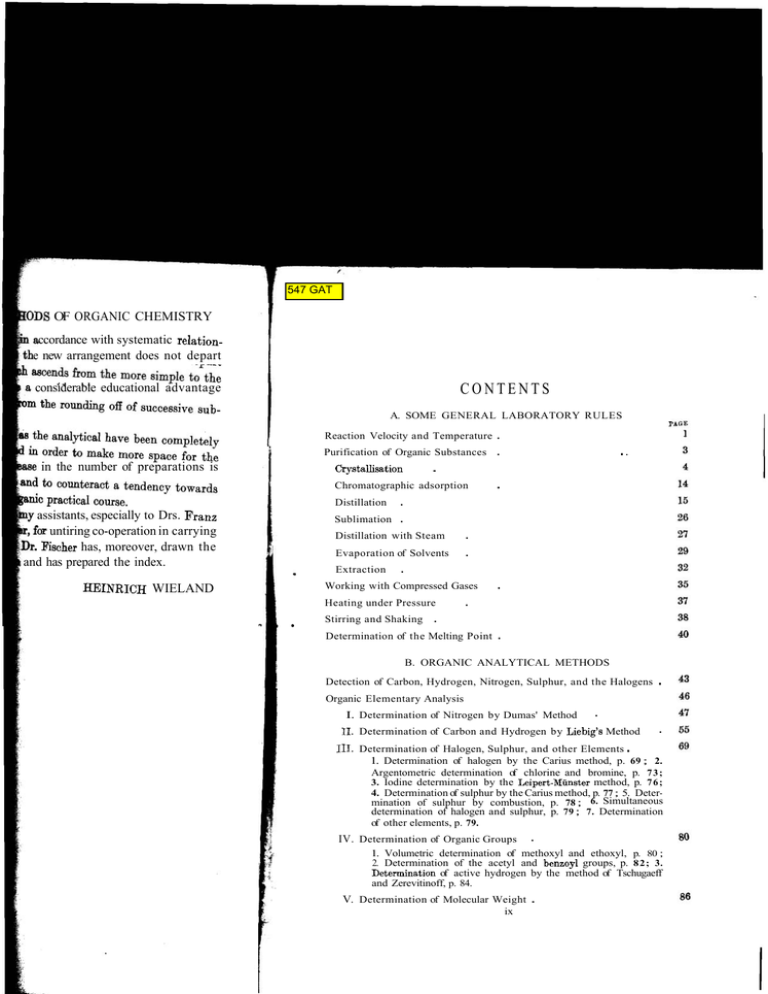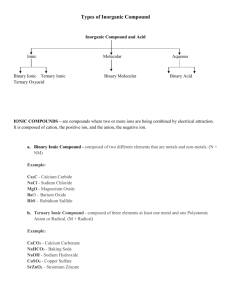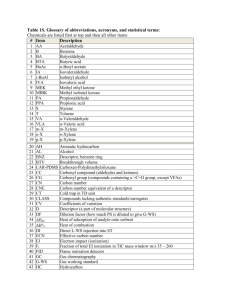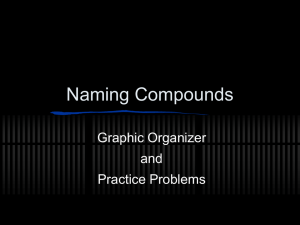Document 10324233
advertisement

547 GAT
ODs OF ORGANIC CHEMISTRY
ccordance with systematic relatione new arrangement does not depart
CONTENTS
considerable educational advantage
A. SOME GENERAL LABORATORY RULES
1
Reaction Velocity and Temperature
Purification of Organic Substances
in the number of preparations is
Chromatographic adsorption
assistants, especially to Drs. Franz
r untiring co-operation in carrying
. E'ischer has, moreover, drawn the
and has prepared the index.
Sublimation
Evaporation of Solvents
.
.
.
Working with Compressed Gases
HEINRICH WIELAND
Heating under Pressure
b
.
Stirring and Shaking
I
/
i
.
.
.
Determination of the Melting Point
I
.
.
.
Distillation with Steam
Extraction
..
.
Crystallisation
Distillation
.
.
.
B. ORGANIC ANALYTICAL METHODS
Detection of Carbon, Hydrogen, Nitrogen, Sulphur, and the Halogens
.
Organic Elementary Analysis
I. Determination of Nitrogen by Dumas' Method
.
11. Determination of Carbon and Hydrogen by Liebig's Method
.
.
111. Determination of Halogen, Sulphur, and other Elements
1. Determination of halogen by the Carius method, p. 69 ; 2.
Argentometric determination of chlorine and bromine, p. 7 3 ;
3. Iodine determination by the Leipert-Miinster method, p. 7 6 ;
4. Determination of sulphur by the Carius method, p. 77 ; 5. Determination of sulphur by combustion, p. 78 ; 6. Simultaneous
determination of halogen and sulphur, p. 79 ; 7. Determination
of other elements, p. 79.
IV. Determination of Organic Groups
.
1. Volumetric determination of methoxyl and ethoxyl, p. 80 ;
2. Determination of the acetyl and benzoyl groups, p. 82; 3.
Determination of active hydrogen by the method of Tschugaeff
and Zerevitinoff, p. 84.
V. Determination of Molecular Weight
ix
.
x LABORATORY METHODS O F ORGANIC CHEMISTRY
111. NITRO-ComOUNDSAND
C. PREPARATIVE PART
On the Prevention of Accidents
.
,
.
Equipment required by the Beginner
PAGE
1. Nitromethane
Methylamine, p. 158,
nitrolic acid, p. 158, Sil
88
.
90
p. 160.
I. THE REPLACEMENT OF H YDROXYL
ALCOHOLS
1. Ethyl bromide from ethyl alcohol
Methyl b'romide, p. 95.
2. Ethyl iodide from ethyl alcohol
Methyl iodide, p. 96.
3. Benzyl chloride from toluene
HYDROGEN
A N D OLEPINES
AND
BY
HALOGEN.
( a ) Nitrobenzene, p.
.
93
.
.
95
.
.
.
4. Bromobenzene
.
p-Dibromobenzene, p. 105.
5. Ethylene from ethyl alcohol.
Ethylene dibromide
6. Glycol from ethylene dibromide
7. Isoamyl ether
.
2. Nitration of an
.
.
.
.
.
.
8. Chlomacetic acid from acetic acid and chlorine .
11. CARBOXYLIC
ACIDS AND
THEIR ~
103
.
3. Acetamide
Benzamide, p. 130.
5. Nitrosobenzene
114
117
6. Hydrazobenzene and azobenzene . {
'
( a ) Hydrazobenzene, p. 183; (6)
p. 184; (c) Benzidine from h y d
the reduction of nitrobenzene, p la
118
.
126
.
129
.
Nitrosobenzene from aniline and
from aniline and nitroeobemne, p.
hydroxylamine and nitrosobenzene,
107
~ DERIV.~WES
L
E
.
.
4. Phenylhydroxylamine
p-Aminophenol, p. 176, Nitrosophe
100
1. Acid chlorides
.
. 121
( a ) Acetyl chloride, p. 121 ; ( 6 ) Benzoyl chloride, p. 121 ; Acetanilide,
p. 125 ; Benzoyl peroxide, p. 125.
2. Acetic anhydride
3. Reduction of a nitro-compound to
( a ) An'iline from nitrobenzene,
isothiocyanate, p. 169; ( 6 ) mp. 171.
- 1. Benzene monosulphonic acid from ba
Diphenylsulphone, p. 191, Bern
Benzenesulphonamide, p. 192, Ba
192.
2. Toluene-p-sulphonicacid
.
.
,
131
4. Urea and semicarbazide
( a ) Potassium cyanate by oxidative fusion, p. 131 ; (6) Urea, p. 132 ;
( c ) Semicarbazide, p. 134 ; (d) Urea (and uric acid) from urine, p. 135.
.
3. Naphthalene-P-sulphonic acid
.
5. Nitriles
( a ) Acetonitrile, p. 137 ; ( 6 ) Benzyl cyanide, p. 137.
.
137
5. 2 : 4-Dinitro-a-naphthol-7-sulphoni
6. Hydrolysis of a nitrile to the acid. Phenylacetic acid
.
140
4. Sulphanilic acid from aniline and 8d
Thiophenol, p. 201.
.
7. Esters
141
(a) Ethyl acetate from acetic acid and alcohol, p. 141, Ethyl benzoate,
p. 141 ; ( b ) Isoamyl nitrite, p. 146, Ethyl nitrite, p. 147-; (c) ~ t h ~ l
nitrate, p. 148; (d) Hydrolysis of fat or vegetable oil, p. 149 ; Preparation of the free fatty acid, p. 150, Glycerol, p. 150; Analysis of fats,
p. 151.
.
8. Conversion of carboxylic acids into the next lower amine8
.
( a ) The Hofmann reaction. Methylamine from acetamide, p. 152 ;
(6) The Curtius reaction, p. 153, Benzoyl azide, p. 153, Phenyl
cyanate, p. 153, Phenylurethane, p. 154.
152
.
1. Formaldehyde
Determination, p. 204.
.
t
?
2. Acetaldehyde
( a ) From ethyl alcohol, p. 205 ; (b:
3. Benzaldehyde from benzylidene ohk
Paraldehyde, p. 217. h~etaldehgde,
4. Cannizzaro's reaction. Benzoic
benz~ldehyde .
.
.
.
95
100
103
(a) Aniline from nitrobenzene, p. 165, Diphenylthiourea, Phenylisothiocyanate, p. 169 ; (b) m-Nitraniline from m-dinitrobenzene,
p. 171.
.
4. Phenylhydroxylamine
p-Aminophenol, p. 176, Nitrosophenylhydroxylamine, p. 177.
5. Nitrosobenzene
.
.
174
,
179
Nitrosobenzene from aniline and Caro's acid, p. 179, Azobenzene
from aniline and nitrosobenzene, p. 181, Azoxybenzene from phenylhydroxylamine and nitrosobenzene, p. 182.
.
6. Hydrazobenzene and azobenzene .
183
(a) Hydrazobenzene, p. 183 ; (b) Azobenzene from h~drazobenzene,
p. 184 ; (c) Benzidine from hydrazobenzene, p. 186. Mechanism of
the reduction of nitrobenzene, p. 188.
IV. S a ~ ~ o m
ACIDS
o
oyl chloride, p. 121 ; Acetanilide,
.
191
1. Benzene monosulphonic acid from benzene and sulphuric acid
Diphenylsulphone, p. 191, Benzenesulphonyl chloride, p. 192,
Benzenesulphonamide, p. 192, Benzenesulphohydroxemio acid, p.
192.
2. Toluene-p-sulphonic acid
.
3. Naphthalene-P-sulphonic acid
fueion, p. 131 ; (6) Urea, p. 132 ;
(and uric acid) from urine, p. 135.
.
.
4. Sulphanilic acid from aniline and sulphuric acid
.
5. 2 : 4-Dinitro-a-naphthol-7-sulphonic acid (naphthol yellow 8 )
.
.
.
Thiophenol, p. 201.
Phenyhetic acid
.
01, p. 141, Ethyl benzoate,
nitrite, p. 147 ; ( c ) Ethyl
table oil, p. 149 ; Preparap. 160; Analysis of fats,
next lower amines
.
e from acetamide, p. 152 ;
0yl azide, p. 153, Phenyl
.
Formaldehyde
Determination, p. 204.
.
Acetaldehyde
(a) From ethyl alcohol, p. 205 ; (b) from acetylene, p. 209.
Benzaldehyde from benzylidene chloride
Paraldehyde, p. 217, Metaldehyde, p. 217.
Cannizzaro's reaction.
benzaldehyde
.
Benzoic scid and benzyl alcohol from
193
194
195
195
xii LABORATORY METHODS OF ORGANIC CHEMISTRY
.
.
CONTEI
PAGE
B. Aromatic Diaz
5. Acyloin condensation. Benzoin from benzaldehyde
222
Benzil from benzoin, p. 222, Benzilic acid, p. 225.
6. Addition of hydrogen cyanide to an aldehyde. Mandelic acid from
. 227
benzaldehyde .
7. Alanine
229
8. Perkin's synthesis. Cinnamic acid from benzaldehyde and acetic
anhydride
232
Hydrogenation of cinnamic acid, p. 234, Sodium amalgam, p. 234.
9. The Reimer-Tiemann synthesis. Salicylaldehyde from phenol and
chloroform
.
. 235
p-Hydroxybenzaldehyde, p. 236.
.
3. Diazotisation of aniline. Phenol, ioc
aniline. Isomerism of the diazo-(
(a) Preparation of a solution of a di
version of the diazonium salt to pheno
(c) Iodobenzene fromaniline,~.283, PL
Iodobenzene, p. 284 ; (d) Benzene f
phenyldiazonium chloride, p. 286, P
phenyldiazonium ~erbromide,p, 289,l
p-nitrophenyl-anti-diazotate,
p. 290.
.
.
.
4. p-Tolunitrile from p-toluidine ( S a n b Benzonitrile, p. 292, p-Toluic acid, p.
5. Arsanilic acid from p-nitraniline
VI. PHENOLS
AND
ENOLS.
KETO-ENOL TAUTOMERISM
6. Phenylhydrazine
1. Conversion of a sulphonic acid into a phenol. /.?-Naphthol .
Phenyl benzoate, p. 241, Naphthyl benzoate, p. 242, Tribromophenol, p. 242.
2. Methylation of phenols
.
(a)Anisole, p. 244 ; (b) p-Naphthyl methyl ether, p. 244.
3. Ortho- and para-Nitrophenols
.
4. Kolbe's salicylic acid synthesis
5. Synthesis of the ester of a P-keto-acid. Acetoacetic ester .
.
.
Benzene from phenylhydrazine, P. 28
.
7. Preparation of azo-dyes
(a) Helianthine, p. 300 ; ( b ) Congo
p. 303, Diazoaminobenzene and p-am
On the coupling reaction of the diazo
.
.
1. Quinone from aniline
Quinol, p. 311, Anilinoquinone, p. 31
.
6. Acetylacetone
Benzoylacetone, p. 253.
7. Diethyl malonate :
Diethyl ethylmalonate, p: 254, Ethylmalonic acid, p. 255, Butyric
acid from ethylmalonic acid, p. 265.
8. Phenylnitromethane
.
(a) mi-Phenylnitroacetonitrilesodium, p. 256; (b) Sodium salt of
aci-phenylnitromethane, p. 256.
On keto-en01 tautomerism .
The use of ethyl acetoacetnte and ethyl malonate for synthetic
purposes
.
2. p-Nitrosodimethylaniline
Dimethylamine and p-nitrosophenol
.
3. p-Aminodimethylaniline
Wurster's red, p. 319, Bindschedlel
p. 322.
.
4. Basic triphenylmethne dye8
Malachite green from benzddeh~
Lead dioxide, p. 325.
6. Fluorescein and eosin
.
Triphenylmethane dyes. Theoretic
6. Alizarin
VII. THE DIAZO-COMPOUNDS
General
.
.
.
IX. TEE GRIGNARDAND 3
269
ortarno
A . Aliphtic Diazo-Compounds
The Qrip
.
1. Diazomethsne
. 271
Nitrosomethylurea, p. 271.
2. Ethyl diazoacetate
. 275
(a) Glycine ethyl eater hydrochloride, p. 276, Hippuric acid, p. 277 ;
(b) Ethyl diazoacetate, p. 277.
.
1. Preparation of alcohols
t '
.
(a) Benzohydrol from benzaldehyc
p. 337 ; (b) Triphenylcsrbinol
nesium bromide, p. 338.
2. Synthesis of s ketone from a nit&
OF ORGANIC CHEMIST'RY
...
CONTENTS
XU1
B. Aromatic Diazo-Compounds
from benzaldehyde and acetic
4, Sodium amalgam, p. 234.
cylaldehyde from phenol and
4. p-Tolunitrile from p-toluidine (Sandmeyer's reaction)
Benzonitrile, p. 292, p-Toluic acid, p. 292.
5. Arsanilic acid from p-nitraniline
KETO-ENOL
TAUTOYERISM
.
.
291
.
293
.
.
.
1. Quinone from aniline
Quinol, p. 311, Anilinoquinone, p. 311, Quinhydrone, p. 314.
2. p-Nitrosodimethylaniline .
Dimethylamine and p-nitrosophenol, p. 316.
.
.
305
.
309
.
314
.
.
257
for synthetic
.
296
3. p-Aminodimethylaniline
317
Wurster's red, p. 319, Bindschedler's green, p. 321, Methylene blue,
p. 322.
P. 256; (b) Sodium salt of
.
.
.
7. Preparation of azo-dyes .
300
(a) Helianthine, p. 300 ; (b)Congo red, p. 302 ; (c) 8-Naphthol orange,
p. 303, Diazoaminobenzene and p-aminoazobenzene, p. 303.
alonic acid, p. 255, Butyric
s
.
.
On the coupling reaction of the diazo-compounds
Acetoacetic ester
.
6. Phenylhydrazine .
Benzene from phenylhydrazine, p. 299 ; Synthesis of indole, p. 299.
henol. @Naphthol .
benzoate, p. 242, Tribromo-
.
PdQE
3. Diazotisation of aniline. Phenol, iodobenzene, and benzene from
281
aniline. Isomerism of the diazo-compounds
(a) Preparation of a solution of a diazonium salt, p. 281 ; (b) Conversion of the diazonium salt to phenol by boiling the solution, p. 282 ;
(c) Iodobenzene from aniline, p. 283, Phenyl iodochloride,Iodosobenzene,
Iodobenzene, p. 284; (d) Benzene from aniline, p. 285 ; (e) Solid
phenyldiazonium chloride, p. 286, Phenyldiazonium nitrate, p. 287,
Phenyldiazonium perbromide, p. 289, Phenyl azide, p. 289 ; ( f ) Sodium
p-nitrophenyl-anti-diazotate, p. 290.
aldehyde. Mandelic acid from
264
4. Basic triphenylmethane
dyes
.
324
*
Malachite green from benzaldehyde and dimethylaniline, p. 324,
Lead dioxide, p. 325.
. 326
5. Fluorescein and eosin
.
Triphenylmethane dyes.
6. Alizarin
Theoretical considerations
.
.
.
327
.
334
IX. THE G ~ N A RAD
ND FRIEDEL-CRA~S
SYNTHESES.
O B Q A ~RADICLES
O
The Gignard Reactian
.
.
acid, p. 277 ;
275
1. Preparation of alcohols
.
337
(a) Benzohydrol from benzaldehyde and phenyl magnesium bromide,
p. 337 ; (b) Triphenylcarbinol from ethyl benzoate and phenyl magnesium bromide, p. 338.
CONTENT
xiv LABORATORY METHODS OF ORGANIC CHEMISTRY
.
5. Lactose and casein from milk
Acid hydrolysis of casein, p. 392.
6. d-Galactose from lactose .
Mucic acid, p. 393, Pyrrole, p. 393.
7. Octa-acetylcellobiose and cellobiose
Some remarks on carbohydrates .
The FriedeZ-Crafts Synthesis
.
3. Synthesis of a ketone
.
(a) Benzophenone from benzoyl chloride and benzene, p. 343; the
Beckmann rearrangement, p. 344 ; (b) Acetophenone from benzene
and acetic anhydride, p. 346.
4. Triphenylchloromethane from benzene and carbon tetrachloride
.
5. 2 : 4-Dihydroxyacetophenone from resorcinol and acetonitrile
6. Quinizarin from phthalic anhydride and quinol
.
.
PlOE
343
346
347
348
Organic Radiclea
.
.
7. Hexaphenylethane
8. Tetraphenylhydrazine
Diphenylnitrosamine, p. 357.
.
.
352
355
I
k
I
i
I,
.
.
.
.
.
XI. HYDROGENATION
AND
REDUCTION.
OZONISATION
1. Catalytic hydrogenation with palladium .
.
Preparation of palladinised animal charcoal, p. 378 ; Preparation of
platinum oxide, p. 379.
2. Catalytic hydrogenation with nickel. Cyclohexanol .
Cyclohexane, p. 381.
3. Replacement of the oxygen in carbonyl compounds by hydrogen.
376
.
379
.
383
(a) Ethylbenzene from acetophenone, p. 383; (b) Dibenzyl from
benzil, p. 383.
4. Adipic aldehyde from cyclohexene by ozonieation
.
384
(Reduction by Clemmenaen'e method)
.
XII. NATURAL PRODUOTS
.
1. Furfural
2. d-Glucose from cane sugar
3. Hydrolysis of cane sugar by saccharase
4. P-Penta-acetylglucose and a-acetobromoglucose
.
.
.
.
.
.
386
388
388
390
.
8. Saccharification of starch and alcoholic
i
t
1. Pyridine derivatives
361
( a )Hantzsch's collidine synthesis, p. 361 ; (b)a-aminopyridine, p. 365.
2. Quinoline
366
(a) Skraup's quinoline synthesis, p. 366 ; (b) Quinaldine synthesis of
Doebner and Miller, p. 367.
3. Indigo
369
Phenylglycine, p. 369, IndoxyI fusion, p. 369, Indigo vat, p. 372,
Dehydroindigo, p. 374.
.
9. d-Arginine hydrochloride from gelattin
.
10. Caffeine h r n tea
11. Nicotine *om tobacco extract
12. Haemin from ox blood
.
.
.
.
Chromatographic adsorption of pigment
13. The chief constituents of ox bile
GIycochoIic acid, p. 411, Cholic acid,
Fatty acids, and Cholesteral, p. 413.
Hints for using the Literature of Organic
Preparations from the Original Liter
Table for Calculations in the Determination


